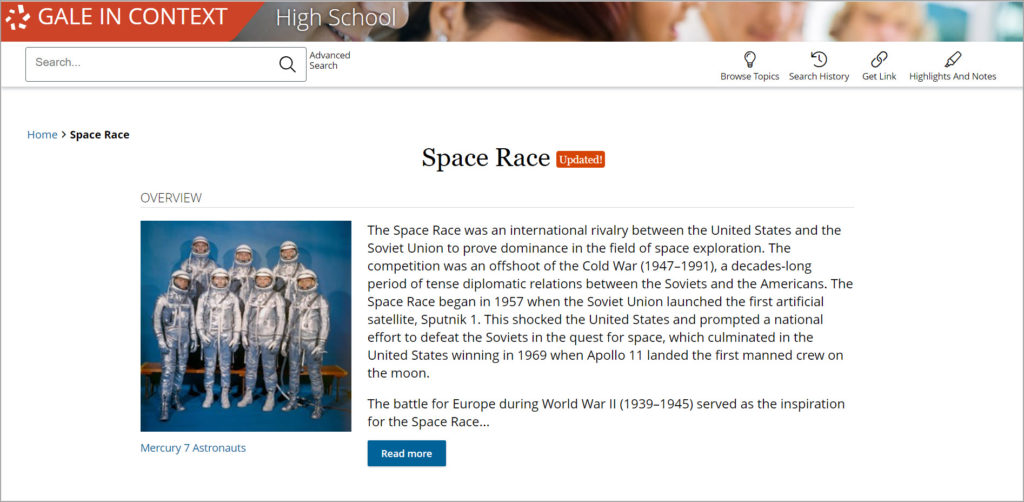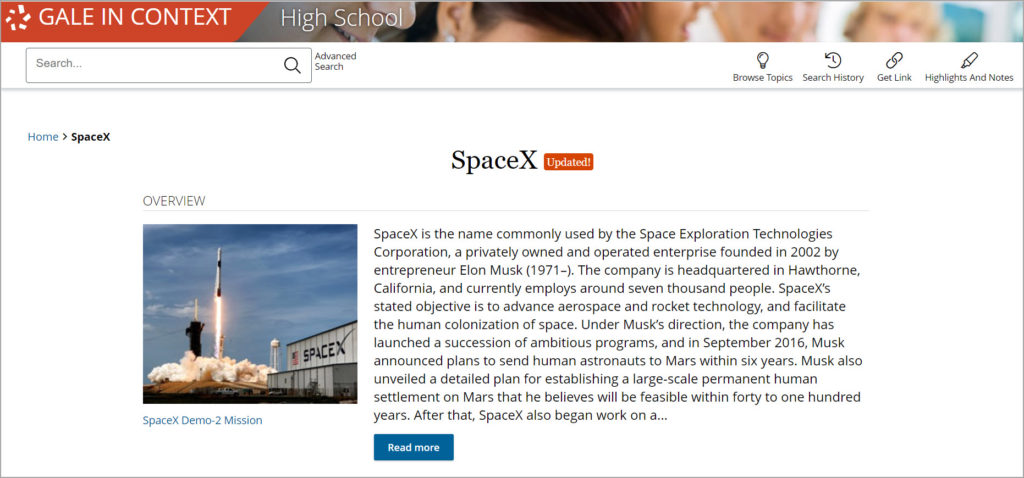| By Gale Staff |
Most millennials and zoomers won’t remember the Space Race, a time when the United States and the former Soviet Union competed to lead the world in space exploration, largely for military gain. In 1962, President John F. Kennedy promised the country we would land on the moon; by 1969, Neil Armstrong was the first person in the world to walk on the lunar surface. NASA’s Space Shuttle Program captivated a generation, dominating the news cycle and creating celebrities out of astronauts. Eventually, tensions with the former Soviet Union eased, space exploration became increasingly costly, and the Space Shuttle Program ended.

Yet here we are again—the U.S. relationship with Russia is collapsing, and once again, outer space is in the news. Only this time, space exploration looks a little different. Celebrities are riding in space shuttles, and people can track the James Webb Space Telescope in real-time on their smartphones. When the U.S. government pulled its funding for NASA, private billionaires stepped in to fill the gaps, making space exploration a commodity—albeit an expensive one.
There’s a lot of buzz about space exploration, but with Gale In Context: High School, you can create interdisciplinary lessons that are out of this world.
Guide Students Through the History of the Space Race
Outer space is no small topic, so your high schoolers should learn the history of U.S. space exploration before diving in further. No matter what subject you teach, you and your students will find valuable content on the history of the Space Race in Gale In Context: High School. Start with our featured Space Race summary, which presents information in a clear, user-friendly format. Additionally, articles include dozens of embedded hyperlinks and suggestions for high school research, helping your students curate their learning towards sub-topics that most interest them.
There is a lot of information to unpack about the topic, but your high schoolers will have no problem navigating the bite-size paragraphs supplemented with a helpful timeline. Instructors may consider leveraging our built-in critical thinking questions to inspire class discussion or create assignments. For example: Why did the launch of Sputnik cause panic in the United States? Students can find news articles and primary sources from that time period to glimpse into real perspectives from the 1960s.
Discussion Idea: Ask students to consider parallels between the United States of the 1960s and the United States of today. How have political tensions or social movements possibly contributed to increased support for space exploration?
Navigating Modern Space Exploration
Space is cool again, and your high schoolers are no doubt already aware of the major recent space events that “broke the internet.” In October 2021, William Shatner (of Star Trek fame) went to outer space, and former NFL player Michael Strahan followed just two months later. On Christmas Day 2021, NASA live-streamed the launch of the James Webb Space Telescope, the largest telescope of all time. This past September, NASA’s Double Asteroid Redirection Test successfully altered the course of an asteroid—bringing relief to everyone who has seen Armageddon. Meanwhile, SpaceX is working on its mission to Mars.

With Gale In Context: High School, students can access thousands of vetted, relevant space-related magazines and news articles. Encourage students to explore the latest information related to space exploration, pushing them to consider how these innovations could change society. Will space travel be an affordable commodity in the near future? Is NASA or SpaceX making any headway on Mars? Is the U.S. Government concerned about UFOs?
Activity Idea: How hard is it to launch a rocket? Watch videos of real rocket launches and the people behind the scenes in mission control. Guide students in designing their own water bottle rockets that can actually be “launched” outside.
Use Space to Introduce More Students to STEM
The current buzz around outer space presents educators with a great opportunity to get more students excited about STEM. Use space lessons to teach students about the solar system, physics, Earth Science, and more. You may inspire a future astronaut in your classroom!
Gale In Context: High School creates a supportive, user-friendly learning environment that engages students with science, helping more learners connect with the inspiring history of human space exploration and the possibilities current innovations present.
Not a Gale In Context: High School subscriber? Find more information or connect with your rep to request a trial.

